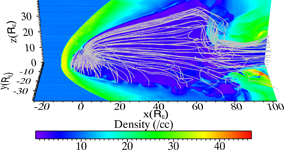HOME > Magnetosphere > GEMSIS-GM
GEMSIS-Magnetosphere
Development of a High-Resolution Global MHD Simulation Model of the Earth’s Magnetosphere

We have developed a high-resolution, global MHD simulation model of the Earth’s magnetosphere which is able to capture magnetic field turbulence. Our goal is to understand the transport and acceleration of plasma interacting with the turbulent fields and its impact on the geospace environment. As the solar wind and IMF becomes abnormal conditions, plasma turbulence are strongly excited near boundary layers in the magnetosphere. In the plasma sheet magnetic reconnection occurs in patchy and intermittent manner to produce streamer-like structure. At the magnetopause, more regular vortex train is formed for northward IMF.
- We compared our CIP-based global MHD model with the model based on the modified leapfrog (MLF) scheme (Ogino et al., 1992). We found that the two simulation models gave consistent results for the magnetopause locations at the subsolar point and the terminator and the overall structures of the cusp in the meridian plane. However, discrepancies were found in the location and jump conditions of the bow shock. The MLF model showed higher thermal pressure values and weaker magnetic field strengths downstream than the CIP model. The difference in the jump condition across the shock results in the difference in the length of the magnetotail between the two models. The magnetotail is shorter in the CIP model than in the MLF model. We believe that further comparative studies with finite-volume methods are necessary to verify the solution of the bow shock formation and the location of the last closed field line under northward IMF conditions.
- We analyzed fundamental quantities of MHD equations by introducing spatial derivatives of MHD quantities. The parallel current are excited by parallel vorticity, on the other hand, the perpendicular current are done by perpendicular vorticity and compressibility. Fast and slow magnetosonic modes can be also identified by comparison of the perpendicular current, vorticity and compressibility. In particular, it is noted that fast magnetosonic mode is strongly excited in the reconnection region.
Reference: Matsumoto et al., JGR, 2010
 Japanese
Japanese